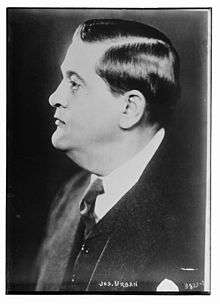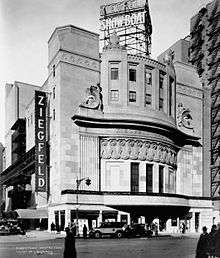Joseph Urban
Joseph Urban (May 26, 1872 – July 10, 1933) was an Austrian-American architect, illustrator and scenic designer.[1][2]
Joseph Urban | |
|---|---|
 Joseph Urban (c. 1915) | |
| Born | May 26, 1872 |
| Died | July 10, 1933 (aged 61) New York City, New York, U.S. |
| Occupation | Architect, illustrator, scenic designer |
| Spouse(s) | Mary Porter Beegle (m. 1919) |
Life and career


Joseph Urban was born on May 26, 1872, in Vienna. He received his first architectural commission at age 19 when he was selected to design the new wing of the Abdin Palace in Cairo. He became known around the world for his innovative use of color, his pointillist technique, and his decorative use of line. He designed buildings throughout the world from Esterhazy Castle in Hungary to the Ziegfeld Theatre in New York.
Urban studied architecture at the Academy of Fine Arts Vienna under Karl von Hasenauer. In 1890, he and his brother-in-law, Heinrich Lefler, were among the founders of the Hagenbund. Urban's early work with illustrated books was inspired by Lefler and, together, they created what are considered seminal examples of children's book illustration.
Urban immigrated to the United States in 1911 to become the art director of the Boston Opera Company. He was already an accomplished international architect, illustrator and theatre set designer with over 50 productions from his home Vienna Royal Opera, the Champs Elysée Opera, and Covent Garden. By applying points of primary colors side by side on the canvas backdrops he was able to create and light theatre sets of vivid color reminiscent of the works by Monet or Seurat. In 1914 he moved to New York City, where he designed productions for the Metropolitan Opera and the Ziegfeld Follies;[3] he continued to design for Florenz Ziegfeld Jr. until 1931.[4] William Randolph Hearst was an important client and supporter. He also co-produced with Richard Ordynski Percy MacKaye's "Community Masque" Caliban by the Yellow Sands.[5]
Beginning in 1917, he was frequently engaged as stage designer by the Metropolitan Opera of New York City. In all he created set designs for 47 new productions at the house through 1933. His many designs provided the opera company with a cohesive production style throughout the tenure of General Manager Giulio Gatti-Casazza. Many of Urban's settings remained in the company's repertoire into the 1950s.
Soon his sets and innovative lighting caught the eye of Florenz Ziegfeld Jr., who hired him to design the Follies in the 1920s. Urban went to work creating a stunning night-club with glass balconies, a moving stage, and rainbow lighting effects. This Danse de Follies soon became a blend of ideas and talent before serving in the Follies theatre. Urban had success after success in his creating of the Follies' sets, and William Randolph Hearst, a media tycoon, took notice and wanted to hire Urban to work on his films starring Marion Davies, his mistress, and previous Follies starlet. Hearst came to an understanding with his friend Ziegfeld that Urban's work for him would not interfere with any of the Follies productions. Urban worked on 25 films over the years.
Urban died July 10, 1933, of a heart attack at his apartment at the St. Regis Hotel in Manhattan, where he had been convalescing following surgery in May.[1]
Legacy
Urban was one of the originators of the American Art Deco style. Most of his architectural work in the United States has been demolished. Extant buildings include the Mar-a-Lago in Palm Beach, Florida; The New School building in New York City;[3] and the base of the Hearst Tower in New York City. The stage lighting gel Roscolux Urban Blue #81, still used today, is named for him.[3]
[4]Work
Architecture and interior design


_002.jpg)

This partial list[6] omits unrealized projects.
- 1900: Wohn- und Bürohaus Wien 8, Buchfeldgasse 6 (with Hermann Stierlin)
- 1902: Villa Goltz, Wien 19, Grinzinger Straße 87
- 1903: Villa Wiener, Wien 13, Veitingergasse 21
- 1904: Exhibition space, Austrian Pavilion, Louisiana Purchase Exposition, St. Louis, Missouri[7]
- 1907: Villa Redlich, Wien 19, Kreindlgasse 11
- 1907: Wohnhaus, Wien 19, Krottenbachstraße 11
- 1907: Villa Max Landau, Semmering, Südbahnstraße 83
- 1910: Villa Dr. Mair, Scheiblingkirchen, Kreuzackergasse 43
- 1920: Sherman Hotel Panther Room, Chicago[8]
- 1922: Wiener Werkstätte showroom, New York City[9]
- 1925: C.C. Lightbown House, 4839 Colorado Avenue, NW, Washington, DC, Permit #7278, March 10, 1925, cost $25,000.
- 1926: Mar-a-Lago, Palm Beach, Florida[9]
- 1926: Demarest Little Castle, Palm Beach, Florida
- 1926: Paramount Theatre, Palm Beach, Florida[7]
- 1927: Anthony Biddle residence, Palm Beach, Florida[7]
- 1927: Bath and Tennis Club, Palm Beach, Florida[7]
- 1927: Ziegfeld Theatre, New York City[9]
- 1926–27: St. Regis Hotel Roof Garden[9]
- 1928: Hotel Gibson Roof Garden, Cincinnati, Ohio
- 1928: Bossert Hotel, Grill Room, Brooklyn
- 1928: Bedell Store, New York City[9][7]
- 1928–29: William Penn Hotel, Urban Room, Pittsburgh, Pennsylvania[10]
- 1929: International Magazine Building, New York City[9]
- 1929: Central Park Casino
- 1929: Metropolitan Museum of Art 11th annual exhibition of American Industrial Art
- 1929: The Gingerbread Castle, Hamburg, New Jersey[11][12]
- 1930: The New School for Social Research, New York City[7]
- 1929–31: Atlantic Beach Club, Long Island, New York[9]
- 1931: Park Avenue Restaurant, 128 E 58th Street[13]
- 1932: Congress Hotel, Joseph Urban Room, Chicago, Illinois
- 1929: Urban Room, Omni William Penn Hotel, Pittsburgh, Pennsylvania[14]
- 1933: Katherine Brush Apartment
- 1933: Color scheme for the Century of Progress International Exposition
Book illustrations
- 1905: Grimm's Märchen
- 1907: Kling-Klang Gloria
- 1911: Andersen Kalender
- 1914: Marienkind
References
- "Joseph Urban Dies; Versatile Artist". The New York Times. July 11, 1933. Retrieved January 17, 2014.
- Paul Goldberger (December 20, 1987). "At the Cooper-Hewitt, Designs of Joseph Urban". The New York Times. Retrieved January 17, 2014.
- "Guide to the 66 West Twelfth Street Architectural Plans and Drawings 1924–1986". Archives and Special Collections. The New School. Retrieved February 14, 2016.
- Henderson, Amy; Bowers, Dwight Blocker (1996). Red Hot and Blue: A Smithsonian Salute to the American Musical. Washington, D.C.: Smithsonian Institution Press. p. 47. ISBN 1-56098-698-0.
- Mackaye, Percy (1916). Caliban by the Yellow Sands. New York: Doubleday Page & Co. pp. 153.
- Archived September 16, 2005, at the Wayback Machine
- Ostergard, Derek E. (2000). "Assimilation and Eclecticism: The Architecture of Joseph Urban". Architect of Dreams: The Theatrical Vision of Joseph Urban. Columbia University Libraries. Retrieved February 14, 2016.
- Cannan, Gwynedd (2000). "The Joseph Urban Collection: An Overview Gwynedd Cannan". Architect of Dreams: The Theatrical Vision of Joseph Urban. Columbia University Libraries. Retrieved February 14, 2016.
- Aronson, Arnold (2000). "Architect of Dreams: The Theatrical Vision of Joseph Urban". Columbia University Libraries. Retrieved February 14, 2016.
- "Checklist of the Exhibition". Architect of Dreams: The Theatrical Vision of Joseph Urban. Columbia University Libraries. 2000. Retrieved February 14, 2016.
- "Wheatsworth Mill and Gingerbread Castle". Preservation New Jersey. Archived from the original on March 5, 2016. Retrieved February 14, 2016.
- https://www.nj.com/sussex-county/index.ssf/2018/10/nj_gingerbread_castle_getting_much-needed_makeover.html
- Photograph of Park Avenue Restaurant
- Archived February 13, 2008, at the Wayback Machine
- Randolph, Carter; Cole, Robert Reed (1992). Joseph Urban: Architecture, Theater, Opera, Film. Abbeville Publishing Group (Abbeville Press, Inc.). ISBN 0-89659-912-4.
- Aronson, Arnold; Ostergard, Derek E.; Smith, Matthew Wilson (2000). Architect of Dreams: The Theatrical Vision of Joseph Urban. NY NY: Columbia University. ISBN 1-884919-08-1.
- Goldberger, Paul (December 20, 1987). "At the Cooper-Hewitt, Designs of Joseph Urban". New York Times. Retrieved June 22, 2009.
- "Joseph Urban". Architecture. LXIX (5): 251–290. May 1934.
Further reading
- Curl, Donald W. "Joseph Urban's Palm Beach Architecture". Florida Historical Quarterly 71(April 1993): 436-457.
External links
| Wikimedia Commons has media related to Joseph Urban. |
- Finding aid to the Joseph Urban papers at the Rare Book and Manuscript Library, Columbia University
- Joseph Urban's Stage Design Models and Documents Project Columbia University
- Cinema Treasures on Urban
- Hearst Tower Photographs
- New School for Social Research
- Historic American Landscapes Survey (HALS) No. NJ-4, "The Gingerbread Castle, Wheatsworth Road, Hamburg, Sussex County, NJ", 8 data pages
- Antiquity Echoes History, photos, and video of the Gingerbread Castle in Hamburg, NJ.
- Joseph Urban at the Internet Broadway Database
